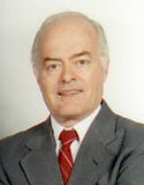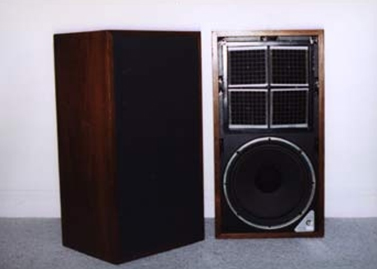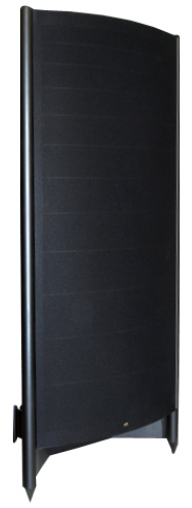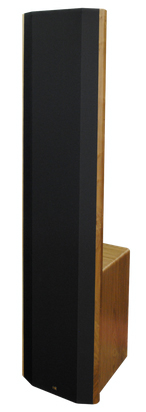I have always been a huge fan of Roger West. owner and designer of Sound Lab electrostatic panel speakers. I make no apologies for my love of his giant Ultimate I full-range electrostatic speakers. I have listened to thousands of speakers over my 52 years in audio, from the very cheapest to systems costing over a million dollars. But for me, the most realistic sound with the very best presentation is the Sound Lab Ultimate I. (For me, it’s my Majestic 645. -Pub.)
I sold Sound Lab speakers for many years when I was in retail, so I will admit to a bias when it comes to Roger West and his products. Roger has had a long and fruitful career that puts him on the list of the world’s best speaker designers ever. The following is an interview with Roger West. I sincerely hope you enjoy it.
Q: When did you first become interested in speaker design and audio in general?
Roger West: My initial exposure to audio came from a young man named Ray Dolby (creator of Dolby Labs) that lived two houses up the street from me. We attended high school together and we became friends. I was impressed by his intense interest in sound reproduction, which rubbed off on me and became of great interest. Our association continued into college years and beyond. We both studied electronic engineering at San Jose State University. Ray worked for Ampex Corporation, who developed and manufactured professional audio and video tape recorders. He invited me to attend the first promotional demonstration of a stereo tape recorder designed for use in Hollywood productions, which introduced the miracle of stereo sound to movies. This only added to my addiction to audio.
Q: Can you tell our readers something about your early years growing up?
Roger West: My father was a structural engineer and also had a contracting business in the San Francisco Bay Area. He designed and built many beautiful homes and smaller commercial buildings. I worked for him during summers as an apprentice carpenter and other construction duties. He was a great example and greatly influenced my interest in engineering.
Q: I understand you attended Santa Clara University. What was your area of study?
Roger West: During early college I worked part time for Jobbins Electronics, a small California company that manufactured electronic transformers and solenoids that used coils made of oxidized aluminum foil instead of varnished wire. After earning a bachelor of science degree in electronic engineering (BSEE) I was employed in the Bay Area aerospace industry as an electronics engineer for seven years as a member of a team developing electronics for satellite tracking systems. I worked for both Philco-Ford and Sylvania Electronic Products. Sylvania had a program that supported working part time on advanced degrees, of which I took advantage. This effort culminated in a master’s degree in electronics engineering from Santa Clara University.
Q: You received your Doctorate from Stanford University, a PhD with a specialty in Psycho-Acoustical Engineering. This seems like a leap from your studies at Santa Clara. What prompted your interest in psycho-acoustics?
Roger West: All the time I was working in the aerospace business I was nurturing my interest in high-end audio. I made friends with a physician at the Stanford Medical Center who read a report I had written for one of my engineering classes having to do with how different approaches to amplifier designs affect the perception of music. He requested my permission to let a colleague read the paper, to which I consented. His colleague, who was the department head of the audiology and psycho-acoustics department of the medical school, invited me to his office and point blank offered me a fellowship to study psycho-acoustics. I was astounded by his offer and without any hesitation accepted it. Thus, began my life at Stanford resulting in a special doctorate I refer to as psycho-acoustical engineering. I also accepted a three year post-doctoral scholarship in which I deepened my studies of psycho-acoustics as related to audio design.
Q: Utah is a beautiful state. When did you decide to move to Utah and why?
Roger West: My family roots are in Utah and I lived there until I was about 10 years old, long enough to develop roots. At that time my father worked for the government as a structural engineer. He was transferred to California, where I attended college and worked in the aerospace industry as an electronics engineer. I always nursed a desire to return to Utah.
Q: As you know, I have been a huge fan and promoter of electrostatic speakers for over 45 years and am proud to say I was one of your dealers for many years. How did you get involved with electrostatic speaker development? Who influenced you and how?
Roger West: Though I’ve had an interest in high-end audio from a relatively young age I had no idea that I would be professionally involved in it. Here’s how it happened. When I finished my post doc stint, I was interested in finding a teaching position at a Utah university. I applied at several institutions and Utah State University offered me a position, but they were unable to fund it immediately. I was asked if I could “tread water,” so to speak, until funding came. At the time I had a friend who was a vice president of a Minnesota corporation, Electronic Industries. The corporation owned several companies, including one by the name of JansZen Electrostatic. Upon learning of my delayed career situation, my friend suggested that I temporarily come to Minnesota and develop some fresh speaker designs for them until things worked out at the University. I actually felt a surge of excitement come over me and accepted his offer.
My initial excitement grew roots and I decided to remain for a while. I was offered the position of Vice President of Engineering which, after some thought, I accepted. Teaching at the University would have been a nice career but compared to audio design it didn’t hold the romance aspect for me. I spent seven years at JansZen designing a new series of speakers, including an advanced electrostatic panel that we still use in our hybrid models today. I also had a small personal company on the side and developed Phantom Powering, which made professional condenser microphones compatible with the industry standard three-conductor cable systems, for which I received a patent.
Q: You and Dale Ream founded Sound Lab back in 1978. How did you meet Dr. Dale Ream and what was your motivation for creating Sound Lab? but I don’t know anything about your career history prior to that time. Would you like to elaborate on that?
Roger West: I met Dale while I was a student at Stanford. At the time he was completing his medical degree. I introduced him to high-end audio and he became “hooked” like me. We continued our friendship during the time I worked at JansZen Electrostatic. I mentioned to him one day that I thought it would be possible to develop a truly full-range electrostatic speaker. He strongly encouraged me to work on the concept. I was finally convinced of the possibility of a truly full-range electrostatic speaker and asked the hierarchy of Electronic Industries for permission to proceed in this direction. I was flatly turned down as they were only interested in small hybrid-type speakers from a marketing standpoint. Upon mentioning this to Dale he suggested that we form our own full-range electrostatic speaker company, which was the beginning of Sound Lab.
Q: What is the basic philosophy for Sound Lab designs?
Roger West: I could probably write a book in answer to this question, but I’ll keep it short. In contemplating what the perfect loudspeaker approach might be I initially considered the following parameters:
-
- A single membrane from which all frequencies would radiate. This would preserve the phase relationship of all frequencies in the music being reproduced. In technical terms this means perfect time-alignment.
- Eliminate as much as possible anything that creates an anomaly within the audio spectrum. This suggests among other things the elimination of the use of an enclosure and implies a dipole radiator configuration.
- Uniform full-spectrum radiation throughout the listening room and simultaneously reducing wall, floor and ceiling reflections. The line-source configuration using controlled full-spectrum horizontal dispersion satisfies this requirement. Anywhere within the dispersion limits of the speaker the frequency response should not vary.
- Bass response down to the 20Hz range with acceptable dynamics.
- Provision for independent adjustment of bass frequencies, mid frequencies and high frequencies to compensate for differing acoustical environments, variations of recording characteristics, audio equipment differences and personal taste. This is necessary since most available pre-amps no longer provide frequency compensation.
- Immunity from changes in the environment, such as line voltage variations, changes in temperature and humidity, and so forth.
- Good sensitivity and excellent reliability.
- An acceptable physical appearance.
For the sake of brevity, I found that a properly designed single-membrane, push-pull electrostatic panel that was tall enough to be considered a reasonable line source fulfilled the above requirements. If one desires to understand how I came to these conclusions I recommend reading the “White Paper” that I’ve placed on our website. [Also see Design Notes 3: Sound Lab “The Complete White Paper”]
Q: Over the years, have you discovered any issues related to electrostatic loudspeaker technology?
Roger West: Basically, I feel that the only limitations to electrostatic speaker technology rest with the designer. I submit that thunder and lightning represent the “great electrostatic speaker in the sky,” which says a lot for the possible dynamic range and ultimate potential of the technology. On a practical level, developing a high-end electrostatic speaker has presented quite a few issues, such as the ability of the materials in the speaker to withstand high voltage potentials, sea-salt atmospheres, cold and hot temperatures, a membrane resistant to air-borne particulates such as tobacco smoke, cooking oil droplets, insect spray, plant fertilizer spray, UV and anything else that might possibly occur within a home environment. After completing the design phase, which is pretty much straight forward, I encountered the most challenging aspect: reliability. Finding materials that can withstand high voltages, reasonable abuse and adverse environmental factors has taken years to accomplish. Like Thomas Edison, he knew of 10,000 things that won’t make a reliable light bulb filament, we likewise became familiar with many materials and approaches that don’t satisfy the necessary requirements of a truly high-end electrostatic speaker. The carrot we are chasing is that as the Sound Lab electrostatic speaker technology continues to advance, we are convinced it will someday be seen as the most ideal speaker technology due to the very low moving mass and the uniform driving force over the entire moving membrane.
Q: As many of our readers are aware, Sound Lab has become one of the most renown and respected High End speaker manufacturers. Would you like to elaborate on what you attribute your success to?
Roger West: Of course, there is more than one facet to the meaning of “success”. High profitability is probably the most common interpretation, but that is not our highest success priority. I consider that we have been and are very successful in terms of technical development, high quality production and customer satisfaction. Without doubt we’ve been sufficiently successful from an income standpoint to sustain our business for over 40 years. Notwithstanding, I would say that the most important element as to why Sound Lab has continued in business for such an extended period is, in one word: perseverance. I’m sure that most developers have made mistakes, and we are certainly no exception. Over the challenging times we have not lost the vision of our goal: an optimized truly full-range electrostatic speaker. Many different materials and techniques have been tried and many have not worked out. In contrast, through 40 years of persistence we have discovered materials and designs that are essential to the success of our products. I look upon our company as a research and development organization that makes an adequate profit to continue doing business.
Q: Do your speakers utilize a crossover?
Roger West: Our basic design incorporates a special audio step-up transformer for lower frequency reproduction and a toroidal audio step-up transformer for high frequency reproduction. Both of these transformers are optimized for the segment of the audio spectrum that they cover. To restrict the operation of these units to the band pass for which they are optimized, filters are required. The upper frequency that the low-frequency transformer rolls off is precisely the lower frequency limit of the toroidal transformer. This filter network could be referred to as a crossover network, since it does essentially the same job as a network that separates a dynamic woofer and tweeter. However, our panels do not employ separate drivers, and therefore I personally don’t like to use the term “crossover” since in many people’s minds it suggests the use of separate drivers.
Q: Do you have your own take that makes your speakers distinct?
Roger West: From the beginning our intent has been to eliminate as many factors as possible that cause the performance of speakers to depart from accurate reproduction, both spectrally and spatially. To achieve this ideal we employ the following techniques. The main feature is the use of a single membrane from which all frequencies radiate, providing perfect time alignment of all frequencies. Secondly, the frequency spectrum of the off-axis response of the speaker should not vary from that of the on-line spectral response so that listening off-axis provides the same sound quality as listening on-axis, thus providing an off-axis realistically skewed image. Thirdly, using a line-source format, which greatly reduces the image-damaging reflective field in the listening room, and which provides a life-size image when standing or sitting.
Q: You have been getting stellar reviews of your speakers for decades, and are probably best known for your ultra high-end speakers. You have expanded the line over the years to include hybrid speakers, custom installation speakers, the MiniStat bookshelf speaker and accessories like the S.A.L.L.I.E., Do you have any plans for more expansion with different products like that?
Roger West: As you mention, we have explored different approaches and applications of electrostatic speaker technology. From a purist standpoint we feel that the single-membrane line-source is the epitome of our efforts, but necessarily the size is large due to the large radiating area requirements of reproducing lower frequencies. Since full-range panels are large and relatively costly to manufacture we have developed a line of hybrids that employ conventional dynamic woofers, which reduces size and cost. Further, we have discovered that the clear, undistorted sound of electrostatic drivers carries the audibility of speech for greater distances than conventional speakers. The comparatively larger size of electrostatic panels increases directivity which also helps to penetrate distance. However, when wider dispersion is desired, we use acoustical lenses to create and control larger dispersion angles. As such, we have very successfully used electrostats in auditoriums and other public venues. Further, we have developed a self-bias technology that eliminates the need to distribute AC power to the speakers. This has resulted in a line of successful commercial electrostatic speakers. We now have a company that markets our products in the commercial market. Our website now includes our commercial products.
Q: I retired a few years ago and started writing for Dagogo. I did a little digging and discovered you may not have road to retirement and a successor for Sound Lab. Do you have any comment as to the future of your company?
Roger West: It is true that I have passed the usual age of retirement. Let me say that I have many things in mind that I would like to research concerning electrostatic technology. I personally feel that the day will come when electrostatic technology will dominate high-end audio. There is still much to be done to realize this, and I want to continue to be a part of it. If for some reason I choose to retire my major employees have been with me for decades and were I to leave the team, the team would definitely continue on without me.
Q: This year has been a challenge for many companies due to the Covid-19 pandemic. Have you had to adapt to deal with the changes in the industry?
Roger West: Quite frankly, my design and development work has for decades been centered in my home laboratory. As a result, I have not personally felt the impact of the pandemic. I had expected that speaker orders might begin to reduce as a result of the lockdowns that the government has decreed, but to my astonishment we are quite busy. I attribute this to the lockdown wherein people spend more time at home. Further, I feel it’s an indication that the power of music is more important in these trying days.
Q: Before we end, is there anything you would like to add?
Roger West: In retrospect, we have always been a smaller sized company ever since we began in 1978. Our intent has been to develop the most perfect electrostatic speaker technology. We have never envisioned becoming a large dominant corporation since electrostatic speakers are a largely unknown technology. Our business model has been to find those people in the world who personally prefer full-range electrostatic speakers. Our advertising has been minimal with the exception of having a website and exhibiting our ware at audio shows, where on occasion we have been dubbed “best sound at the show” by some reviewers. Does this mean that we are the best speakers at the show? Not necessarily since that is a personal opinion. It’s more probable that the reviewer simply prefers electrostatic sound. Our major means of soliciting sales has been by the word of mouth of satisfied customers. In spite of our minimal marketing exposure, we receive inquiries from all parts of the world. Fortunately, there has been a sufficiently large population of electrostatic speaker lovers to keep us in business for over 40 years. Further, marketing by “word of mouth” has resulted in virtually zero dissatisfied customers. We invite people to listen to our products to determine if they are a potential electrostatic speaker enthusiast. If they are, addiction is usually instantaneous.
Occasionally, we are asked the baited question: “Whom do you feel manufactures the best loudspeaker?” My answer is simply, “the one you prefer listening to the most.”We all have different tastes.
My final admonition: “Listen before buying.”
-End of Q&A
Since Roger brought it up, I want to put my vote in and say that Sound Lab are the BEST of SHOW regardless of the competition.
I want to thank Dr. West for his time and valuable information. I also look forward to spending time with him at a future California Audio Show. It has been far too long since I have had the pleasure to visit in person. I also urge any of my readers who have not had the opportunity to experience one of his speakers to reach out to his team to arrange a personal audition.
Copy editor: Dan Rubin
More suggested reading: An Hour With Dr. Roger West (A California Audio Show 2019 Experience)
- (Page 1 of 1)







This was a really interesting look at the history of Sound Lab. I wanted to thank everyone involved for their time putting it together.
Though I’ve never had the opportunity to listen to them, I have been an admirer of Sound Lab speakers for years. I currently “make do” with a single driver cone based system which shares a few of the speaker design goals outlined in this article. Reading Dr. West’s vision here, I’m convinced that a pair of Sound Labs would be my holy grail.
What a humble genius.
I fell hard for electrostatic speakers after owning the original Koss Electrostatic headphones and listening to 4 Seasons through Acoustat 2+2’s in the 70’s. Currently own ML Summits and they satisfy me to no end but would LOVE to get in front of a pair of the big Sound Labs.
Definitely an aspirational speaker whose reputation precedes it.